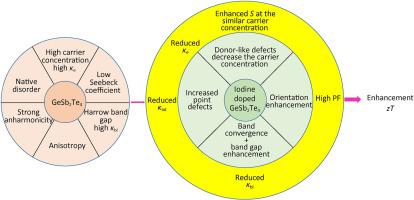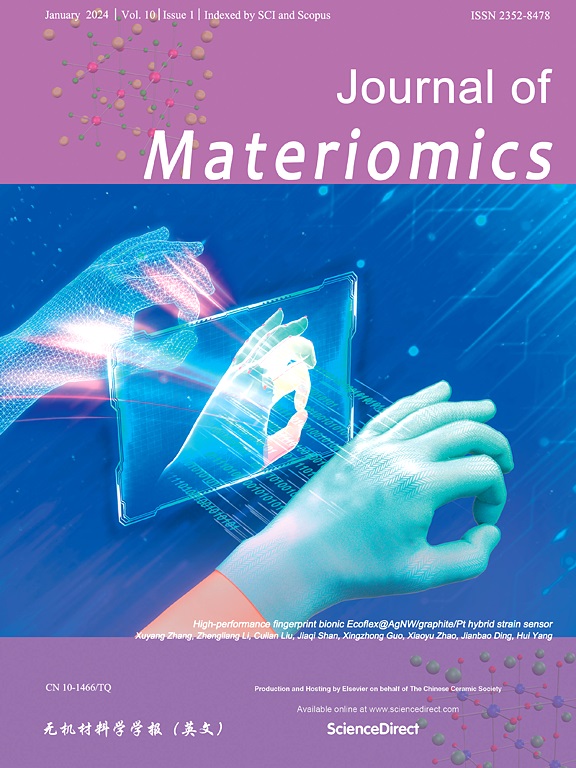Synergistic effects lead to high thermoelectric performance of iodine doped pseudo-binary layered GeSb2Te4
IF 8.4
1区 材料科学
Q1 CHEMISTRY, PHYSICAL
引用次数: 0
Abstract
Pseudo-binary layered compound ⅣVI-V2VI3 families show great promise for application in thermoelectrics. Herein, through introducing iodine in GeSb2Te4, several synergistic effects come into being and contribute to outstanding thermoelectric performance. The ITe donor-like defects suppress the hole carrier concentration from 5.72 × 1020 cm−3 to 2.80 × 1020 cm−3. First-principles calculations reveal that iodine doping increases the band gap from 0.253 eV to 0.302 eV and contributes to valence band convergence. Seebeck coefficient value reaches up to 135.7 μV/K at 773 K, and the power factor values are entirely boosted in the whole temperature region, reaching a maximum value of 12.4 μW⸱cm−1⸱K−2 in GeSb2Te3.96I0.04. Moreover, iodine doping simultaneously reduces the lattice and electronic thermal conductivity, leading to the greatly reduced total thermal conductivity from 2.89 W⸱m−1⸱K−1 in pristine sample to 0.89 W⸱m−1⸱K−1 in GeSb2Te3.84I0.16 at 323 K. Finally, a maximum zT ∼1.12 at 773 K and an average zT ∼0.62 over 323–773 K are achieved in GeSb2Te3.88I0.12. This work puts forward an effective strategy to synergistically optimize phonon and carrier transport properties of pseudo-binary compounds through halogen doping, which may be effective in other similar material systems.


协同效应使掺碘伪二元层状 GeSb2Te4 具有高热电性能
伪二元层状化合物 ⅣVI-V2VI3 族在热电领域的应用前景十分广阔。在这里,通过在 GeSb2Te4 中引入碘,产生了几种协同效应,有助于实现出色的热电性能。ITe 供体样缺陷将空穴载流子浓度从 5.72 × 1020 cm-3 抑制到 2.80 × 1020 cm-3。第一原理计算显示,碘掺杂使带隙从 0.253 eV 增加到 0.302 eV,并有助于价带收敛。在 773 K 时,塞贝克系数值高达 135.7 μV/K,功率因数值在整个温度区域都得到了提升,在 GeSb2Te3.96I0.04 中达到了 12.4 μW⸱cm-1⸱K-2的最大值。此外,碘掺杂同时降低了晶格热导率和电子热导率,导致总热导率从原始样品的 2.89 W⸱m-1⸱K-1大幅降低到 0.89 W⸱m-1⸱K-2。最后,在 GeSb2Te3.88I0.12 中,773 K 时的最大 zT ∼ 1.12,323-773 K 时的平均 zT ∼ 0.62。这项工作提出了一种通过掺杂卤素协同优化伪二元化合物声子和载流子输运特性的有效策略,这种策略可能在其他类似材料系统中有效。
本文章由计算机程序翻译,如有差异,请以英文原文为准。
求助全文
约1分钟内获得全文
求助全文
来源期刊

Journal of Materiomics
Materials Science-Metals and Alloys
CiteScore
14.30
自引率
6.40%
发文量
331
审稿时长
37 days
期刊介绍:
The Journal of Materiomics is a peer-reviewed open-access journal that aims to serve as a forum for the continuous dissemination of research within the field of materials science. It particularly emphasizes systematic studies on the relationships between composition, processing, structure, property, and performance of advanced materials. The journal is supported by the Chinese Ceramic Society and is indexed in SCIE and Scopus. It is commonly referred to as J Materiomics.
 求助内容:
求助内容: 应助结果提醒方式:
应助结果提醒方式:


